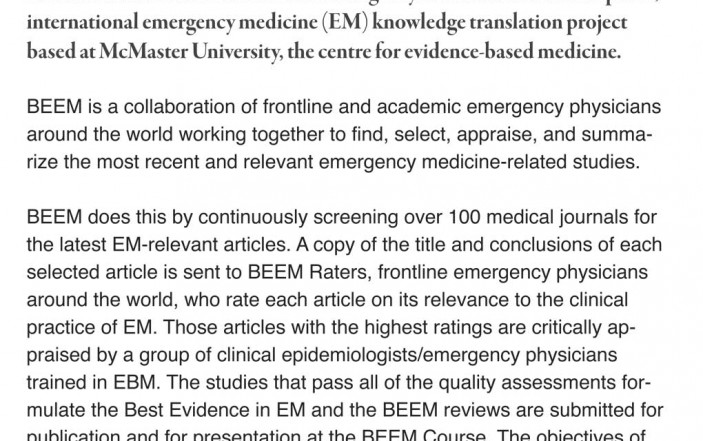A 35 year-old woman comes to the ED complaining of fever and respiratory symptoms for a day; she is terribly worried about swine flu. She has two children in tow, ages 1 and 4 years: the one-year old has been fussy, with a cough, fever, and runny nose, but the 4-year old seems fine. Since the CDC weekly flu update page (www.cdc.gov/flu/weekly) shows that the A/2009 H1N1 strain is still widespread, it is likely that a neuraminidase inhibitor (NAI) like Tamiflu (oseltamivir) or Relenza (zanamivir) will be effective in reducing the duration of symptoms and that the adamantanes (amantadine and rimantadine) will not. Mom’s disease is almost certainly influenza, and though she might benefit slightly from antivirals, the CDC does not recommend routinely treating healthy adults without risk factors. These include age > 65, pregnancy up to 2 weeks post-partum, and certain chronic medical conditions. Mom does not have any of these. But in the course of the visit, mom asks what she should do about the children.
Ever since the rise of pediatric emergency departments early in your career, your pediatric expertise has languished. Should these kids be treated with NAIs?
(a) Treat the one-year old with antivirals, post-exposure prophylaxis for the 4-year old.
(b) Treat the one-year old based on the result of a rapid antigen test, don’t treat the 4-year old.
(c) Treat neither patient with antivirals, since swine flu is a self-limited relatively mild illness.
(d) Look up a systematic review of antivirals for children with influenza.
Treat the 1-year old with oseltamivir, but do not offer post-exposure prophylaxis to the four-year old, given that the likelihood of vomiting, the most common side effect, is about the same as the likelihood of avoiding clinical symptoms.
The CDC considers age less than two a risk factor for severe outcomes for seasonal flu based on the fact that the rate of hospitalization is more than twice the rate for 2-4 year-olds. Thus the CDC recommends the use of antivirals for acute symptoms in this age group. They make the plausible assumption that absolute risk reduction is greater when baseline risk is higher. It is not based on any argument about a unique effectiveness of oseltamivir in toddlers. In fact, there is doubt that this drug has any effect on either the mortality or complications of seasonal flu. (see Common Flu Myths on page 14) Treatment of influenza with NAIs within 2 days of symptom onset is effective in reducing symptom duration by about one day on average, though the two zanamivir trials did not include infants/toddlers. The treatment effect is slightly greater for the subgroup of children with influenza confirmed by testing. There was very little, if any, effect of NAIs on the rate of complications (otitis media, subsequent antibiotic use, or asthma exacerbation), and a very slight excess in the side effect of vomiting (1 additional case per 20) among children given oseltamivir. Three studies of post-exposure prophylaxis with randomization of households showed a small benefit, with only one child in 13 given NAIs avoiding clinical influenza; but side effects of NAIs are likely to be more pronounced in a group of children without acute influenza symptoms.
This is a review of seasonal flu; there are no data on treatment effectiveness against pandemic A/2009 H1N1 yet, though on average symptoms have been relatively mild and suggest that a policy similar to seasonal flu is reasonable. Parental preference or “clinical judgment” often dominates the decision to use antivirals, especially for asymptomatic children exposed to an index case, if there is great fear of severe disease.
One bottle of oseltamivir suspension cost $50 after the discount from mom’s insurance plan, and was sufficient for treating acute influenza in the one-year old. In order to provide this suspension, the pharmacist had to compound it from the content of capsules, a procedure recommended by the CDC when a shortage of suspension led to inadequate supplies nationally. The cost of Tamiflu (2 bottles = $100 for post-exposure prophylaxis for the four-year-old, and $60 for a therapeutic course for mom) and the low expected benefit led mom to follow your advice not to take antivirals.









3 Comments
The home loans seem to be useful for people, which would like to ground their own company. In fact, it’s not hard to receive a term loan.
We thought we might see a re-emerging of the H1N1 this last winter, but fortunately it was not so bad. We were definitely not as busy as last year in the urgent care.
We did offer Tamiflu to many patients who fit the criteria for the flu, but just as in this case, the cost was a great factor in determining whether they filled the prescription or not.
For this statement, Jochen Zeitz argued that a considerable part of the product had being through wind and rain to counter the trend of fail for decades,http://www.monclernetherland.com